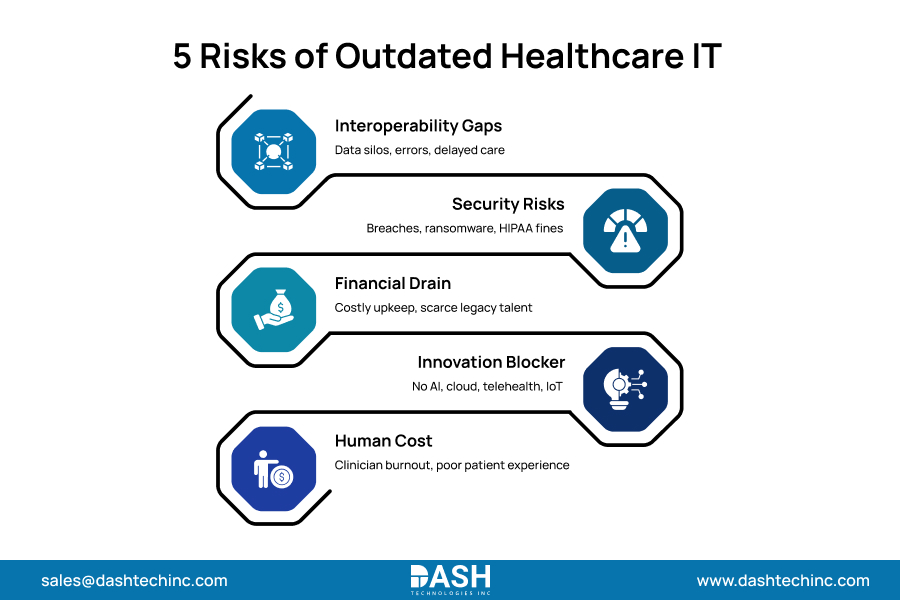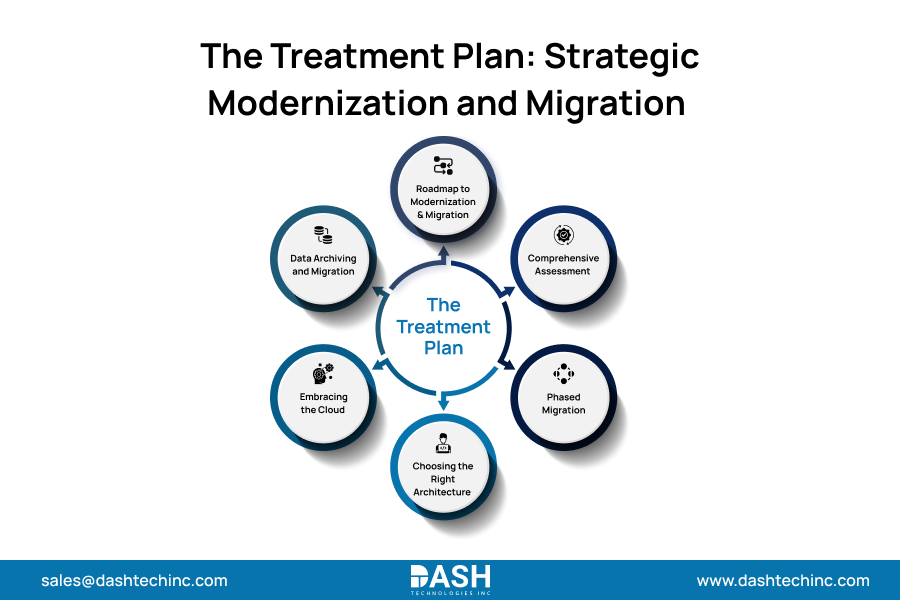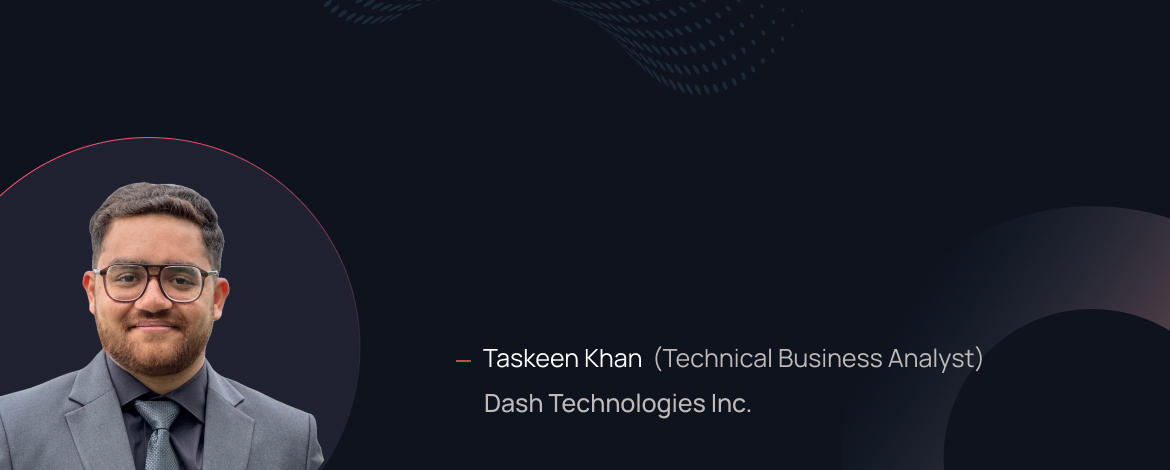Healthcare Digital Transformation : Overcoming Legacy System Hurdles
Recent data shows nearly 73% of healthcare providers still rely on legacy information systems. These outdated systems struggle to meet the interoperability, security, and scalability demands of modern care, often blocking healthcare digital transformation. Legacy IT slows adoption of critical technologies such as AI, predictive analytics, and digital-first patient platforms.
What “legacy” means in healthcare
By legacy systems, we mean old and outdated software, applications, or hardware that were created for a very different age of healthcare. This includes EHRs, billing systems, and lab systems. Most were written in old programming languages. They sit on brittle and fragile infrastructure that cannot support modern advances in cloud computing, data sharing, or cybersecurity.
These systems were created in an age where information was siloed. Data rarely moved across platforms, and security risks were much simpler than the complex threats we face now. Organizations keep using these tools because replacement feels expensive and risky, and many staff remain dependent on them. Skilled experts for maintaining these systems are also scarce, which further increases the need for EHR modernization partners.
Five Ways Legacy Systems Cripple Healthcare Organizations

Depending on old systems is not just inefficient; it puts patient care and business continuity at risk. Here are five areas where legacy tools cause severe damage.
-
The Interoperability Crisis: A Tower of Babel
The Achilles’ heel of Legacy systems in healthcare is their interoperability gap. In today’s healthcare, patient care includes many touchpoints. These are family doctors, specialists, labs, pharmacies, & hospitals. When the systems at each point cannot communicate, the result is a fragmented, incomplete patient record.
This creates dangerous data silos. Doctors make decisions with incomplete records, leading to duplicated tests, errors, & treatment delays. A modern EHR provides a unified record that can include everything from local care providers to Department of Defense data, thereby dramatically improving care coordination and safety. In contrast, outdated systems block this unified view. Strong legacy system migration solutions are needed to remove this barrier. -
The Security Emergency: An Open Door for Cyberattacks
Healthcare is a top target for cybercriminals, and your legacy systems are the weakest link. These systems run on unsupported operating systems and lack modern security protocols. So, they are easy targets for data breaches, ransomware, and other attacks. The result? Patient data breaches can lead to millions in HIPAA fines. They can also cause operational shutdowns that endanger patients’ lives.
Healthcare IT modernization services’ infrastructure relies on a multi-layered defense. It includes AI-driven threat monitoring and Zero Trust architectures. Legacy systems can’t support these defenses. A big breach can cost much more than legacy EHR modernization. So, doing nothing is a risky financial decision. -
The Financial Drain: Unsustainable Maintenance and Scarcity of Talent
Keeping an old system may look cheaper, but the reality is the opposite. Maintaining legacy systems is a heavy financial burden. Costs include frequent hardware upgrades, custom patches for new rules, and constant troubleshooting. It also includes finding rare experts who can handle languages like COBOL or MUMPS, & upgrading failing hardware.
Meanwhile, many skilled IT workers managing old systems are retiring or switching to newer tech. This expertise is rare and costly. Redirecting this money into healthcare IT modernization services makes far more sense. Instead of wasting resources, modernization turns technology into an engine for growth. -
The Innovation Roadblock: Stifling a Digital-First Future
Artificial intelligence (AI), machine learning, cloud computing, & the Internet of Things (IoT) are some of the technologies that are shaping the future of healthcare. These innovations allow for early disease detection through predictive analytics. They also support remote care via telehealth & create personalized treatment plans. Legacy systems are fundamentally incompatible with these modern tools.
Their outdated structure and limited APIs prevent new solutions from integrating. This leaves organizations stuck while competitors move ahead. A hospital with an outdated EHR struggles to establish a telehealth platform. It also struggles to use AI to improve patient flow. This failure to adapt hurts the organization’s advantage. It also limits patient access to the best possible care, which can be easily achieved through healthcare digital transformation. -
The Human Cost: Clinician Burnout and Poor Patient Experience
Slow, clunky, and unintuitive software is a primary source of frustration for clinicians. When doctors & nurses struggle with their EHR system, it leads to burnout. Entering data by hand or waiting for slow records takes time away from patient care.
The patients are also impacted. Legacy systems get in the way of the creation of newer patient engagement capabilities, such as scheduling visits online, viewing lab results, or messaging providers. In a world where everyone wants smooth digital experiences, bad technology causes frustration. This also weakens trust in healthcare organizations.
The Treatment Plan: Strategic Modernization and Migration

Shifting from legacy systems isn’t just a quick “rip and replace.” It’s a big, strategic change for the whole organization with the help of healthcare digital transformation consulting. A good plan is the key to a smooth transition. EHR modernization partners often guide this process. Key strategies include:
- Comprehensive Assessment: First step? A complete audit of the current IT setup. This means mapping dependencies, risks, and critical functions. From this, organizations can design a legacy system migration solution that reduces disruption and builds a clear modernization path.
- Phased Migration: Rather than replacing everything at once, many Healthcare IT modernization services providers take a step-by-step approach. Phased migration lowers risk, updates key systems first, and builds confidence. This staged rollout helps staff get used to new tools. It prevents overwhelming the system.
- Choosing the Right Architecture: Modernization often means shifting from a big, single system to a more adaptable microservices setup. Tools like Kubernetes enable smaller, independent services that are easier to scale and adapt. This provides resilience and agility that legacy systems cannot deliver.
- Embracing the Cloud: Migrating your legacy system to the cloud—whether public, private, or hybrid, with the help of healthcare digital transformation consulting, brings numerous benefits. These include scalability, cost savings, & better accessibility. A cloud-native setup helps organizations scale resources as needed. It also removes the hassle of managing physical hardware.
- Data Archiving and Migration: A critical component is managing historical data. Legacy system migration solutions usually include archiving historical patient records. These records go into a secure, compliant, and accessible repository. This keeps care continuous and meets data compliance and data retention requirements. It also prevents the new system from filling up with outdated information.
The Importance of a Specialized Legacy System Migration Solution Provider
The shift from legacy systems to modern ones is complex. It needs strong technical skills and a clear grasp of the healthcare industry. This is where healthcare digital transformation consulting becomes invaluable. The right partner provides more than just technical implementation; they offer strategic guidance on what healthcare technology consulting is and why it is necessary
An experienced legacy EHR modernization partner will:
- Develop a Strategic Roadmap: Use technology spending to serve long-term objectives and make certain the modernization initiative provides tangible ROI.
- Navigate Vendor Selection: Assist in selecting the best tech vendors you can get and platforms suitable for the organization’s specific requirements and budget.
- Manage Change: Support your team through the transformation. This includes staff training and redesigning workflows for smooth adoption.
- Ensure Compliance and Security: Set up strong security frameworks. Also, make sure all new systems meet regulations like HIPAA.
Don’t let legacy systems hold back your digital goals. Partner with us to transform healthcare. We boost interoperability, improve care, and secure your future.
About Dash

Dash Technologies Inc.
We’re technology experts with a passion for bringing concepts to life. By leveraging a unique, consultative process and an agile development approach, we translate business challenges into technology solutions Get in touch.







